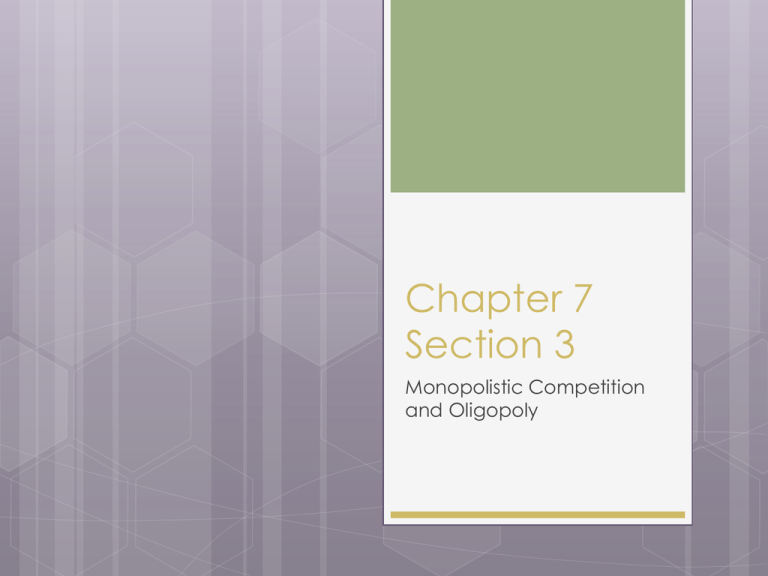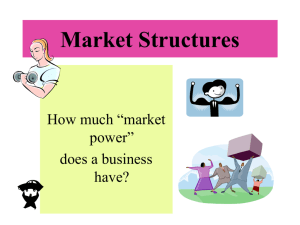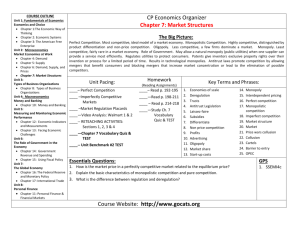Monopoly!
advertisement

Chapter 7 Section 3 Monopolistic Competition and Oligopoly Monopolistic Competition A type of market structure in which many companies sell products that are similar but not identical. But to make their product sell, they have to change it up and be unique. What products do you buy that have similar but slightly varied competitors? How do they vary? Monopolistic Competition Companies hold a monopoly over their own particular product design. These firms sell goods that are similar but not identical. Jeans are an example. (names, styles, colors, and sizes. ) Also, bagel shops, ice cream, and retail stores. The 4 Conditions of M.C. 1. Many firms – low start up costs 2. Few artificial barriers to entry – no patents protecting the basic product identity. 3. Little control over price – If prices raise too high, people will buy a substitute. 4. Differentiated products – prices can be raised slightly because of the variations among competitors. Nonprice Competition A way to attract customers through characteristics other than price. Physical Characteristics New size, color, shape, texture, or taste. These tend to model a person’s personality, job, family, or income. Location Goods are separated by where they are sold. If the item is scarce in a certain area, the price might be higher. If sold in a boutique, the price will be higher. Service Level Firms can charge higher prices if they offer a higher level of service. (restaurants) Advertising, Image, Status Advertising is used to point out differences. Prices, Output, and Profit Monopolistic competition looks similar to perfect competition. Prices – Slightly higher, but limited because other firms can easily enter the market. Output: Prices here are higher than perfect competition, but lower than monopoly. Output falls somewhere in the middle. Law of Demand. Profits: The firms earn just enough to cover all of their costs. If it makes too much profit, a rival firm will work to steal its competition away, or a new firm will enter the market and offer a cheap substitute. Production Costs and Variety: There will be many firms, each with a low output, preventing minimized costs and efficiency; however, consumers can benefit from having a wide variety to choose from. Oligopoly A market dominated by a few large firms. High prices, low output. Examples: air travel, cars, breakfast cereals, and household appliances. Barriers to Entry – There can be barriers: technological or patent/license prevention. Also, the reality is that some companies can and will destroy your small business (Coke and Pepsi) Creates Economies of Scale Cooperation and Collusion - Cheating When an oligopoly occurs, firms will act as though they have a monopoly. Price Leaders Collusion - informal Can set prices and output for entire industries as long as other member firms go along with the leader’s policy. This can also start a price war (undercutting prices) An agreement among members of an oligopoly to illegally set prices and production levels. One outcome is called price fixing (same or similar prices) Cartel – Stronger than Collusion, formal An agreement by a formal organization of producers to coordinate prices and production. Illegal in the US, but OPEC exists internationally. These can collapse if output levels are controlled, but most try to produce more (cheat) and prices will eventually fall. Chapter 7 Section 4 Regulation and Deregulation • What is the cartoon implying about standard oil? • How is this a bad situation for the consumers? Market Power Control Total prices market output Seemingly Monopolistic Competition Tide, Dash, Dreft, Ivory Snow, Bold, Oxydol, Cheer, and Gain are all detergents. ALL are owned by a single company – P&G Government and Competition Antitrust laws are in place to prevent companies from unfairly pushing out competition. Trust = business that has too much market power U.S. has shut down many trusts in the past including: American Tobacco Company, Standard Oil, and AT&T. Overall Markets dominated by one or a few firms tend to have higher prices and lower output than markets with multiple firms. The government can use regulatory laws and deregulation to promote competition, often resulting in more choices, lower prices, and better products for consumers. Market Structure Comparison p.170 Perfect Monopolistic Competition Competition Oligopoly Monopoly Number of Firms Many Many A few dominate One Variety of Goods None Some Some None Control over prices None Little Some Complete Barriers to Entry None Low High Complete Examples Wheat, shares of stocks Jeans, Books Cars, movie studios Public Water






